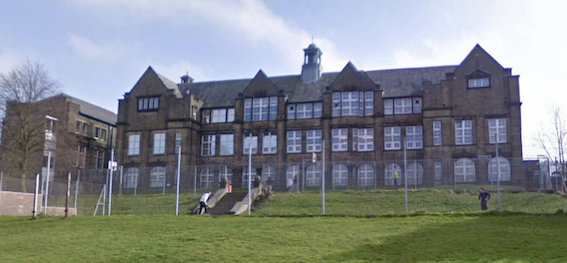¶ Location

Bacup and Rawtenstall Grammar School is a bit of a misnomer - as the school is actually in neither of these places, but rather in the halfway point of Waterfoot, and contrary to popular belief the curriculum spans beyond punctuation and grammar. Built on what was presumably the only bit of land available or the cheapest at the time, as the school is on a steep incline, ensuring its students have some of the strongest leg muscles in Lancashire.
¶ A Quick Summary
The book 'The History of BRGS' is particularly wordy and tends to drag on a lot, talking about how many shillings it cost to pay for a hymm book for a few pages etcetera. To save you the history, we have provided a summary and some highlights of the over 100 page book.
Most of BRGS' history is relatively boring and mostly includes talking about the change from coal to electric heaters and the school's problems with dry rot.
In the past, older students would get new students and either force them to sing in the lunch room or wrap them in a rug in Room 7 and then push them down the coal chute to the boiler house (this initiation ceremony was dubbed "throwing to the lions"). Dear Year 7s, please keep this in mind before trying to pick a fight with one of us older years <3

Currently, in Year 7, your first few geography and history lessons are spent looking for dates on drainpipes and the bomb shelter in school (after spending an hour looking for it, many students were not too impressed when in fact the history teachers told us that there never has been one and it was just a joke question). Upon further research, it turns out this was a double bluff and had lied to us, twice! There is in fact actually a bomb shelter somewhere on school grounds (possible where the staff car park currently is?), and the basement corridor at some point was stocked with sandbags in preparation of an air raid.
¶ Foundation and Ongoing Construction
¶ Main School Building
As every Year 7 student at BRGS learns in their earliest history lessons, BRGS was founded at its current site in 1912, opening to its first intake in 1913, when the Newchurch Grammar School moved. It was built at a cost of £30,000 and was made to house 362 students, with rooms for teaching trades such as weaving, spinning, plumbing and boot and shoe making. Originally opened as Bacup and Rawtenstall Secondary School, it did not adopt the present title and logo until 1928.
It has held many thousands of students over the years, with increasing numbers in recent years, resulting in an ongoing need for construction work. Since 1913, many sections have been added to the school, in fact, over the past few years there has never been a time when BRGS was free from builders and construction work.
¶ Extensions
Permanent construction additions to the school have included the Extension Corridor, which has been the starting point for a number of new extensions, and leads now to the Newchurch Wing, construction finishing at the back end of 1999. The Art Block, completed in 1996, is now too small; the area where it began (currently the Music Department) is also too small to host its named teaching rooms, and the two have now been amalgamated in a new Arts Department.The Clark Building, built in 1990, holds the tiny school Library, and is generally used only for sixth form teaching, and has since been extended to hold the maths department. There is also the English Block which was an attempt to rid the school of any temporary building and consolidate the English department.
The PE Department is in charge of many of the school's land and building assets, with a new £1 million Sports Hall replacing the old Gym in function, the gym has been converted into another Sixth Form-dedicated room; the top field, with 200m running track, space for javelin throwing and rugby and a long jump/triple jump pit - due to be replaced by a second astroturf. They also had the old courts (now the teachers' car park), the new courts, and the large astroturf pitch on the site of the old lower field.
¶ Conquest of Waterfoot
Of course, since starting off as one small main building, BRGS has certainly grown in size. Some wonder if they are planning to extend the school grounds all the way across Waterfoot, others wonder if they have larger plans and wish to take over the whole of Lancashire... either way, it is likely soon BRGS may rival with the Great Wall of China in length and may soon be seen from space.
¶ Links
BRGS Wiki is not responsible for the content of external sites